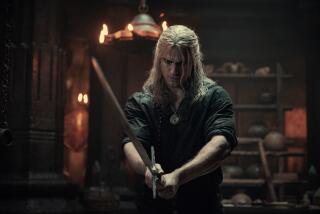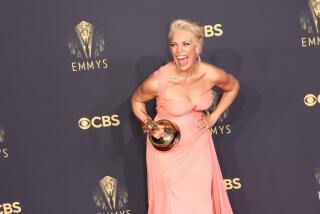Commentary: Women take control in ‘Game of Thrones’ season finale
Was there ever such a reckoning?
The Season 6 finale of “Game of Thrones” was the hour (and 10 minutes) in which the women of Westeros began, with great method and no mercy, to settle all family business.
To be sure, the “ice and fire” parentage of Jon Snow (Kit Harington) was the single biggest revelation of Sunday night’s episode. As many fans have long suspected (and fervently hoped), he is not the son of Ned Stark but of Ned’s sister Lyanna who was kidnapped and raped by Rhaegar Targaryen. Which makes him nephew to Daenerys Stormborn (Emilia Clarke), the unwitting bridge between two warring houses, and, arguably, next in line to the Iron Throne.
Even so, it wasn’t Jon Snow who owned the episode, or, indeed, the season. It was Daenerys, Sansa (Sophie Turner), Cersei (Lena Headey), and Arya (Maisie Williams), characters who, over the course of six seasons, have been sold into marriage or slavery; some raped, most imprisoned; all betrayed, beaten, robbed of wealth, family and home.
Characters who finally put the game of thrones back into play; tables turned as kings fell and queens took their place.
Not all of the causes were righteous — along with the High Sparrow and his followers, Cersei brutally murdered many innocent bystanders, not to mention Queen Margaery (Natalie Dormer) — but after the dizzying and overwhelming battle of Episode 9, the finale advanced all manner of plot lines with such striding confidence that the increasing shift toward female empowerment felt like the natural course of things in Westeros, and beyond.
Still, with Cersei now on the Iron Throne and Daenerys, arrayed in Dothraki and dragons, sailing at last to replace her; with Arya wielding her hard-earned Braavos skills to single-handedly avenge the Red Wedding, and Olenna Tyrell (Diana Rigg) joining with the women of Dorne for some vengeance of their own, this is a very different “Game of Thrones” than the one that began five years ago.
Winter is finally here and, like some epic and bloody version of “Frozen,” it’s the women who seem best prepared to meet it.
Even Jon Snow owes his life, and his status, to women. Well, two women and a girl.
Melisandre (Carice van Houten) brought him back from the dead, Sansa saved him from an ill-conceived attack on the Boltons, but it took the young but mighty Lady Mormont (Bella Ramsey) to officially make him head of House Stark, and therefore King in the North.
“Your son was butchered at the Red Wedding, Lord Manderly but you refused the call. … ” said the child who alone remained true to the old alliances. “But House Mormont remembers. … I don’t care if he is a bastard. Ned Stark’s blood runs through his veins. He’s my king. From this day until his last day.”
Let it go, indeed.
The surprising and smoothly executed shift in power has breathed new life into the series. Though still the most ambitious and generally splendid thing on television, “Thrones” was plagued by the fact that it was fast outstripping its source material — George R.R. Martin has even now not finished the sixth book — and there were times last season when it felt as if it was treading water. (Or sand. Or snow.)
The uber plot — who will rule Westeros and save it from the White Walkers — stalled a bit, with too many of the main characters embroiled in conflict with their own psyches or robed members of some sect or another; even the Night’s Watch had a huge identity crisis.
But now, once again, the game is afoot; apparently, before the great war is fought, a feminist revolution had to occur.
It’s a fine and solid twist for series creators David Benioff and D.B. Weiss who faced not only the daunting task of working, for the most part, without a novel, but the increasing wrath of social media.
Last season, Sansa’s horrific wedding night became a flashpoint for viewers who felt that television in general, and “Game of Thrones” in particular, had become far too cavalier in its depiction of rape, sexual assault and violence against women. Certainly Sansa is the most changed of any character; the preening girl who longed for a match with Prince Joffrey has passed through ice and fire herself to become a strong and canny Stark, closer in courage and resolution to her sister Arya than previously seemed possible.
The increasing estrogen levels also go a little distance in solving HBO’s larger woman problem — despite the success of female-led comedies, the network’s dramas and their creators still skew hyper-masculine. A female-led “Game of Thrones” may not have been the show the network wanted (or bought), but with “Vinyl” flopping and trouble plaguing a series on Lewis and Clark and two projects from David Fincher, it is exactly what HBO needs.
And not just HBO. Though female leads are more numerous than they once were, television, like film, still tends to believe one is enough for any show — you can have a band of brothers but unless you are Shonda Rhimes or, this year, “Orange is the New Black,” a group of women make a comedy, not a drama.
Tell it to the Hand, say the women of “Game of Thrones.”
Or better yet, tell it to his queen.
More to Read
The complete guide to home viewing
Get Screen Gab for everything about the TV shows and streaming movies everyone’s talking about.
You may occasionally receive promotional content from the Los Angeles Times.







